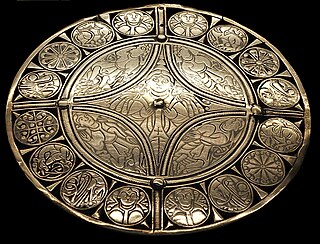
The Fuller Brooch is an Anglo-Saxon silver and niello brooch dated to the late 9th century, which is now in the British Museum, where it is normally on display in Room 41. The elegance of the engraved decoration depicting the Five Senses, highlighted by being filled with niello, makes it one of the most highly regarded pieces of Anglo-Saxon art.

A brooch is a decorative jewelry item designed to be attached to garments, often to fasten them together. It is usually made of metal, often silver or gold or some other material. Brooches are frequently decorated with enamel or with gemstones and may be solely for ornament or serve a practical function as a clothes fastener. The earliest known brooches are from the Bronze Age. As fashions in brooches changed rather quickly, they are important chronological indicators. In archaeology, ancient European brooches are usually referred to by the Latin term fibula.
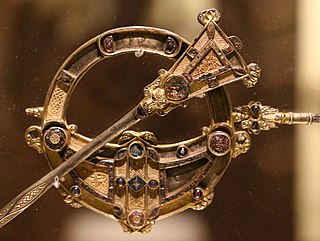
The Tara Brooch is an Irish Celtic brooch, dated to the late-7th or early-8th century, of the pseudo-penannular type. It is made from bronze, silver and gold, with a head formed from a circular ornate ring that is intricately decorated on both sides. Its upper half is hollow while the lower half is solid with fused terminals. The brooch was constructed from numerous individually made pieces, and its front and reverse sides are both decorated with around 50 inserted cast panels containing highly ornate filigree. The borders and terminals contain multiple panels holding multi-coloured studs, interlace patterns, filigree and Celtic spirals. The brooch is widely considered the most complex and ornate of its kind, and would have been commissioned to be worn as a fastener for the cloak of a high ranking cleric or as ceremonial insignia of high office for a High King of Ireland in Irish Early Medieval society.

Niello is a black mixture, usually of sulphur, copper, silver, and lead, used as an inlay on engraved or etched metal, especially silver. It is added as a powder or paste, then fired until it melts or at least softens, and flows or is pushed into the engraved lines in the metal. It hardens and blackens when cool, and the niello on the flat surface is polished off to show the filled lines in black, contrasting with the polished metal around it. It may also be used with other metalworking techniques to cover larger areas, as seen in the sky in the diptych illustrated here. The metal where niello is to be placed is often roughened to provide a key. In many cases, especially in objects that have been buried underground, where the niello is now lost, the roughened surface indicates that it was once there.
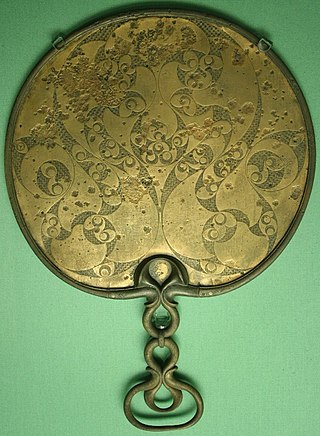
Celtic art is associated with the peoples known as Celts; those who spoke the Celtic languages in Europe from pre-history through to the modern period, as well as the art of ancient peoples whose language is uncertain, but have cultural and stylistic similarities with speakers of Celtic languages.

Anglo-Saxon art covers art produced within the Anglo-Saxon period of English history, beginning with the Migration period style that the Anglo-Saxons brought with them from the continent in the 5th century, and ending in 1066 with the Norman Conquest of England, whose sophisticated art was influential in much of northern Europe. The two periods of outstanding achievement were the 7th and 8th centuries, with the metalwork and jewellery from Sutton Hoo and a series of magnificent illuminated manuscripts, and the final period after about 950, when there was a revival of English culture after the end of the Viking invasions. By the time of the Conquest the move to the Romanesque style is nearly complete. The important artistic centres, in so far as these can be established, were concentrated in the extremities of England, in Northumbria, especially in the early period, and Wessex and Kent near the south coast.

Migration Period art denotes the artwork of the Germanic peoples during the Migration period. It includes the Migration art of the Germanic tribes on the continent, as well the start of the Insular art or Hiberno-Saxon art of the Anglo-Saxon and Celtic fusion in Britain and Ireland. It covers many different styles of art including the polychrome style and the animal style. After Christianization, Migration Period art developed into various schools of Early Medieval art in Western Europe which are normally classified by region, such as Anglo-Saxon art and Carolingian art, before the continent-wide styles of Romanesque art and finally Gothic art developed.

The quoit brooch is a type of Anglo-Saxon brooch found from the 5th century and later during the Anglo-Saxon settlement of Britain that has given its name to the Quoit Brooch Style to embrace all types of Anglo-Saxon metalwork in the decorative style typical of the finest brooches. The brooches take their modern name from the rings thrown in the game of quoits, and have the form of a broad ring, or circle with an empty centre, usually in bronze or silver, and often highly decorated. The forms are in a very low relief, so contrasting with other early Anglo-Saxon styles, with detail added by shallow engraving or punching within the main shapes. Dots or dashes are often used to represent fur on the animal forms, as well as lines emphasizing parts of the body. They are fixed with a single, straight hinged pin like those of other Anglo-Saxon ring or Celtic brooches and are further defined by the presence of a slot and pin-stops on the ring.
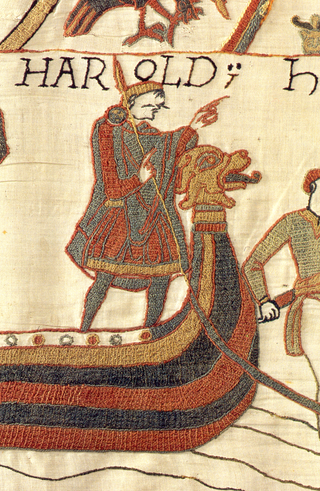
Anglo-Saxon dress refers to the clothing and accessories worn by the Anglo-Saxons from the middle of the fifth century to the eleventh century. Archaeological finds in Anglo-Saxon cemeteries have provided the best source of information on Anglo-Saxon costume. It is possible to reconstruct Anglo-Saxon dress using archaeological evidence combined with Anglo-Saxon and European art, writing and literature of the period. Archaeological finds have both supported and contradicted the characteristic Anglo-Saxon costume as illustrated and described by these contemporary sources.
Trewhiddle is a small settlement in south Cornwall, England, United Kingdom. It lies in the civil parish of Pentewan Valley and the ecclesiastical parish of St Austell. The nearest town is St Austell, approximately one mile to the north.

The Celtic brooch, more properly called the penannular brooch, and its closely related type, the pseudo-penannular brooch, are types of brooch clothes fasteners, often rather large; penannular means formed as an incomplete ring. They are especially associated with the beginning of the Early Medieval period in Ireland and Britain, although they are found in other times and places—for example, forming part of traditional female dress in areas in modern North Africa.

Art in Medieval Scotland includes all forms of artistic production within the modern borders of Scotland, between the fifth century and the adoption of the Renaissance in the early sixteenth century. In the early Middle Ages, there were distinct material cultures evident in the different federations and kingdoms within what is now Scotland. Pictish art was the only uniquely Scottish Medieval style; it can be seen in the extensive survival of carved stones, particularly in the north and east of the country, which hold a variety of recurring images and patterns. It can also be seen in elaborate metal work that largely survives in buried hoards. Irish-Scots art from the kingdom of Dál Riata suggests that it was one of the places, as a crossroads between cultures, where the Insular style developed.
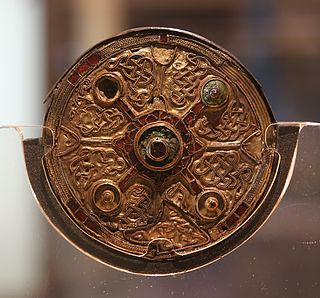
The Harford Farm Brooch is a 7th-century Anglo-Saxon disk brooch. The brooch was originally made in Kent and was found along with a number of other artifacts during an excavation of an Anglo-Saxon cemetery at Harford Farm in Norfolk. The brooch measures 72 millimetres (2.8 in) across and was found in grave 11. The front of the brooch is gold decorated with glass and garnets while the backplate is silver. On the back of the brooch there is a runic inscription reading "ᛚᚢᛞᚪ:ᚷᛁᛒᛟᛏᚫᛋᛁᚷᛁᛚᚫ" (luda:gibœtæsigilæ), which Norfolk Museums & Archaeology Service translates as “Luda repaired the brooch”; however “may Luda make amends by means of the brooch” has been offered as a translation by Alfred Bammesberger in the journal Neophilologus. In addition to the runes, the back of the brooch also has a scratched zoomorphic decoration.
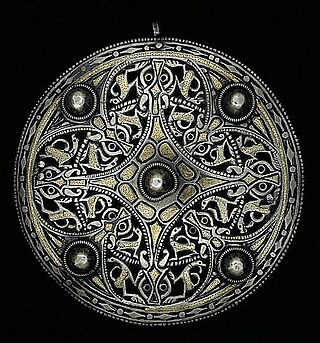
Trewhiddle style is a distinctive style in Anglo-Saxon art that takes its name from the Trewhiddle Hoard, discovered in Trewhiddle, Cornwall in 1770. Trewhiddle ornamentation includes the use of silver, niello inlay, and zoomorphic, plant and geometric designs, often interlaced and intricately carved into small panels. Famous examples include the Pentney Hoard, the Abingdon sword, the Fuller brooch, and the Strickland brooch.
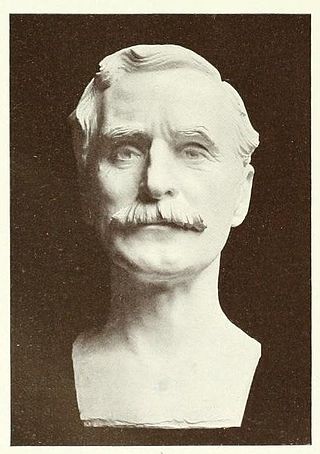
Sir Charles Hercules Read was a British archaeologist and curator who became Keeper of British and Mediaeval Antiquities and Ethnography at the British Museum, and President of the Society of Antiquaries of London, following his mentor Augustus Wollaston Franks in the first position in 1896, and in the second from 1908 to 1914 and again from 1919 to 1924, after being Secretary since 1892. He began periods as President of the Royal Anthropological Institute of Great Britain and Ireland in 1899 and 1917. He was knighted in 1912 and retired from the British Museum in 1921. He usually dropped the "Charles" in his name, especially after he was knighted, though not consistently. "A man of handsome and even striking appearance", he was a major figure in British museum curation in his day, though he published relatively little.

Ædwen's brooch is an early 11th-century Anglo-Scandinavian silver disc brooch with an inscription on the reverse side. It was discovered in 1694 during the ploughing of a field in Sutton, Isle of Ely, Cambridgeshire, along with a hoard including coins and gold rings. The brooch was re-discovered in a private collection in 1951 and bought by the British Museum.

A disc fibula or disc brooch is a type of fibula, that is, a brooch, clip or pin used to fasten clothing that has a disc-shaped, often richly decorated plate or disc covering the fastener. The terms are mostly used in relation to the Middle Ages of Europe, especially the earlier part of the period. They were the most common style of Anglo-Saxon brooches.

Anglo-Saxon brooches are a large group of decorative brooches found in England from the fifth to the eleventh centuries. In the early Anglo-Saxon era, there were two main categories of brooch: the long (bow) brooch and the circular (disc) brooch. The long brooch category includes cruciform, square-headed, radiate-headed, and small-long brooch brooches. The long brooches went out of fashion by the end of the sixth century.

The Pentney Hoard is an Anglo-Saxon jewellery hoard, discovered by a gravedigger in a Pentney, Norfolk churchyard in 1978. The treasure consists of six silver openwork disc brooches, five made entirely of silver and one composed of silver and copper alloy. The brooches are decorated in the 9th century Trewhiddle style. The hoard is now in the British Museum.
The Beeston Tor Hoard is an Anglo-Saxon jewellery and coin hoard discovered in 1924 at Beeston Tor in Staffordshire. The hoard consists of forty-nine coins, two silver brooches with Trewhiddle style decoration, three finger rings, and miscellaneous fragments. The coins date the burial of the hoard to approximately 875 AD.
















